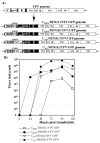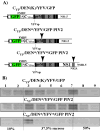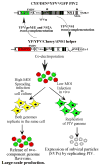Efficient, trans-complementing packaging systems for chimeric, pseudoinfectious dengue 2/yellow fever viruses
- PMID: 20137799
- PMCID: PMC2835813
- DOI: 10.1016/j.virol.2009.12.015
Efficient, trans-complementing packaging systems for chimeric, pseudoinfectious dengue 2/yellow fever viruses
Abstract
In our previous studies, we have stated to build a new strategy for developing defective, pseudoinfectious flaviviruses (PIVs) and applying them as a new type of vaccine candidates. PIVs combined the efficiency of live vaccines with the safety of inactivated or subunit vaccines. The results of the present work demonstrate further development of chimeric PIVs encoding dengue virus 2 (DEN2V) glycoproteins and yellow fever virus (YFV)-derived replicative machinery as potential vaccine candidates. The newly designed PIVs have synergistically functioning mutations in the prM and NS2A proteins, which abolish processing of the latter proteins and make the defective viruses capable of producing either only noninfectious, immature and/or subviral DEN2V particles. The PIV genomes can be packaged to high titers into infectious virions in vitro using the NS1-deficient YFV helper RNAs, and both PIVs and helpers can then be passaged as two-component genome viruses at an escalating scale.
Copyright 2010 Elsevier Inc. All rights reserved.
Figures







Similar articles
-
Using a Virion Assembly-Defective Dengue Virus as a Vaccine Approach.J Virol. 2018 Oct 12;92(21):e01002-18. doi: 10.1128/JVI.01002-18. Print 2018 Nov 1. J Virol. 2018. PMID: 30111567 Free PMC article.
-
Production and characterization of vaccines based on flaviviruses defective in replication.Virology. 2006 Aug 1;351(2):432-43. doi: 10.1016/j.virol.2006.04.003. Epub 2006 May 18. Virology. 2006. PMID: 16712897 Free PMC article.
-
Recombinant chimeric yellow fever-dengue type 2 virus is immunogenic and protective in nonhuman primates.J Virol. 2000 Jun;74(12):5477-85. doi: 10.1128/jvi.74.12.5477-5485.2000. J Virol. 2000. PMID: 10823852 Free PMC article.
-
Guiding dengue vaccine development using knowledge gained from the success of the yellow fever vaccine.Cell Mol Immunol. 2016 Jan;13(1):36-46. doi: 10.1038/cmi.2015.76. Epub 2015 Oct 5. Cell Mol Immunol. 2016. PMID: 26435066 Free PMC article. Review.
-
Preclinical and clinical development of YFV 17D-based chimeric vaccines against dengue, West Nile and Japanese encephalitis viruses.Vaccine. 2010 Jan 8;28(3):632-49. doi: 10.1016/j.vaccine.2009.09.098. Epub 2009 Oct 4. Vaccine. 2010. PMID: 19808029 Review.
Cited by
-
Stability of yellow fever virus under recombinatory pressure as compared with chikungunya virus.PLoS One. 2011;6(8):e23247. doi: 10.1371/journal.pone.0023247. Epub 2011 Aug 3. PLoS One. 2011. PMID: 21826243 Free PMC article.
-
The role of capsid in the flaviviral life cycle and perspectives for vaccine development.Vaccine. 2020 Oct 14;38(44):6872-6881. doi: 10.1016/j.vaccine.2020.08.053. Epub 2020 Sep 17. Vaccine. 2020. PMID: 32950301 Free PMC article. Review.
-
The Multiples Fates of the Flavivirus RNA Genome During Pathogenesis.Front Genet. 2018 Dec 4;9:595. doi: 10.3389/fgene.2018.00595. eCollection 2018. Front Genet. 2018. PMID: 30564270 Free PMC article. Review.
-
Using a Virion Assembly-Defective Dengue Virus as a Vaccine Approach.J Virol. 2018 Oct 12;92(21):e01002-18. doi: 10.1128/JVI.01002-18. Print 2018 Nov 1. J Virol. 2018. PMID: 30111567 Free PMC article.
-
Pseudoinfectious Venezuelan equine encephalitis virus: a new means of alphavirus attenuation.J Virol. 2013 Feb;87(4):2023-35. doi: 10.1128/JVI.02881-12. Epub 2012 Dec 5. J Virol. 2013. PMID: 23221545 Free PMC article.
References
-
- Bredenbeek PJ, Kooi EA, Lindenbach B, Huijkman N, Rice CM, Spaan WJ. A stable full-length yellow fever virus cDNA clone and the role of conserved RNA elements in flavivirus replication. J Gen Virol. 2003;84(Pt 5):1261–8. - PubMed
Publication types
MeSH terms
Substances
Grants and funding
LinkOut - more resources
Full Text Sources
Other Literature Sources

